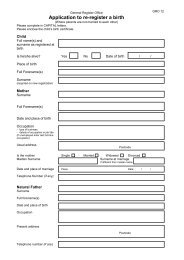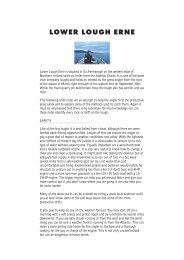an instructors guide to delivering compulsory basic training - NIDirect
an instructors guide to delivering compulsory basic training - NIDirect
an instructors guide to delivering compulsory basic training - NIDirect
You also want an ePaper? Increase the reach of your titles
YUMPU automatically turns print PDFs into web optimized ePapers that Google loves.
2. CBT Syllabus<br />
• develop their earlier skills;<br />
• help ensure their safety if <strong>an</strong> emergency does arise; <strong>an</strong>d<br />
• prepare them for carrying out the exercise during their practical mo<strong>to</strong>rcycle test.<br />
You need <strong>to</strong> find a quiet side road <strong>to</strong> perform this exercise <strong>an</strong>d explain clearly the<br />
signal you intend <strong>to</strong> use.<br />
Initially you should get your pupils <strong>to</strong> perform the exercise at a low speed <strong>an</strong>d as<br />
their skill <strong>an</strong>d ability improves, increase the speed gradually until they c<strong>an</strong> perform<br />
the exercise effective at normal riding speeds. You should always keep pupils within<br />
sight.<br />
However, the braking exercise should not just focus on providing the necessary skills<br />
<strong>to</strong> bring the mo<strong>to</strong>rcycle <strong>to</strong> a controlled s<strong>to</strong>p in the shortest dist<strong>an</strong>ce possible, you<br />
should also discuss with your pupils their underst<strong>an</strong>ding of the:<br />
• effect of speed on braking dist<strong>an</strong>ce, reaction times <strong>an</strong>d overall s<strong>to</strong>pping dist<strong>an</strong>ces;<br />
• effects of different surfaces (their condition), gradients <strong>an</strong>d weather on the above<br />
dist<strong>an</strong>ces;<br />
• riding at <strong>an</strong> appropriate speed for the traffic (the available s<strong>to</strong>pping dist<strong>an</strong>ces are<br />
much shorter at higher speeds);<br />
• condition of brakes <strong>an</strong>d tyres; <strong>an</strong>d<br />
• potential of the rider freezing up in a critical situation.<br />
Basic skills:<br />
• quick reaction <strong>to</strong> the ‘s<strong>to</strong>p’ signal;<br />
• use of both brakes in the appropriate ratio; <strong>an</strong>d<br />
• the ability <strong>to</strong> quickly correct a locked wheel.<br />
Faults <strong>to</strong> avoid:<br />
• riding <strong>to</strong>o slowly before the signal;<br />
• taking rear observation before reacting <strong>to</strong> the s<strong>to</strong>p signal;<br />
• locking one or both wheels <strong>an</strong>d failing <strong>to</strong> correct the fault;<br />
• s<strong>to</strong>pping <strong>to</strong>o slowly; <strong>an</strong>d<br />
• moving off unsafely after s<strong>to</strong>pping.<br />
61









